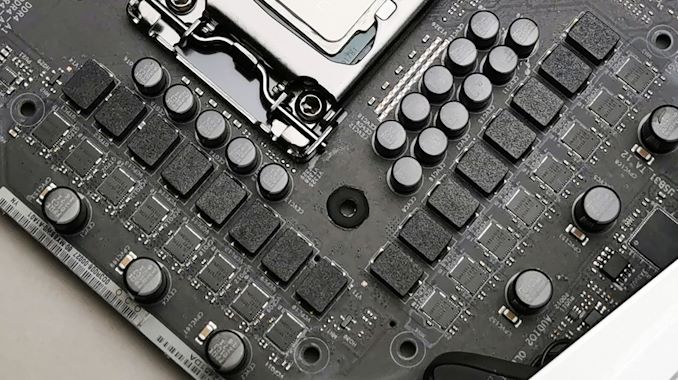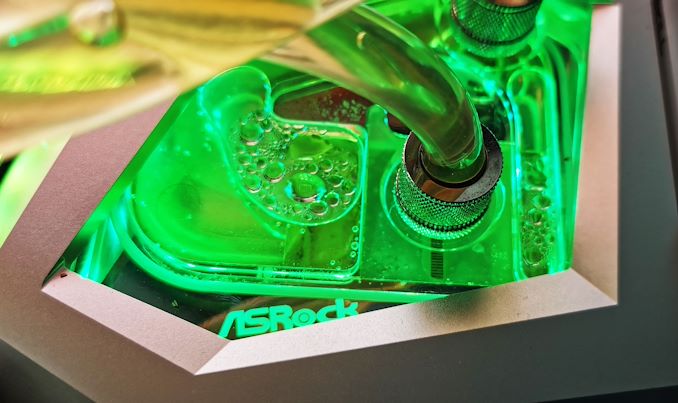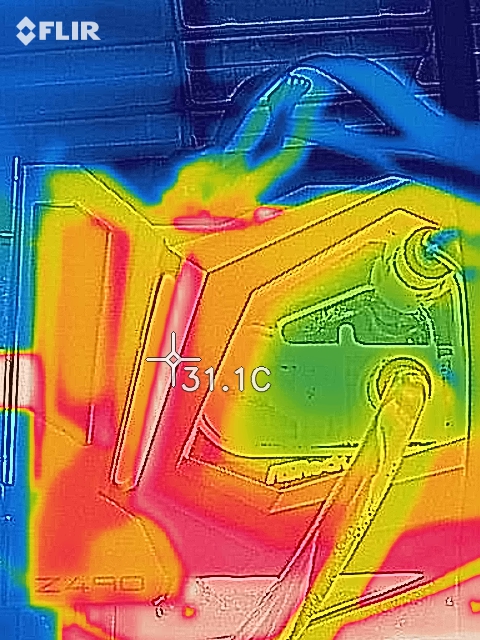ASRock Z490 Aqua Motherboard Review: The $1100 LC Monoblock Flagship
by Gavin Bonshor on October 2, 2020 10:00 AM ESTPower Delivery Thermal Analysis
A lot more focus has been put onto power delivery specifications and capabilities, not just by manufacturers, but as a result of users demands. In addition to the extra power benefits from things like overclocking, more efficient designs in power deliveries and cooling solutions aim to bring temperatures down. Although this isn't something most users ever need to worry about, certain enthusiasts are bringing more focus onto each boards power delivery. The more premium models tend to include bigger and higher-grade power deliveries, with bigger and more intricate heatsink designs, with some even providing water blocks, like the Aqua.

The 14+2 power delivery on the ASRock Z490 Aqua
Testing Methodology
Our method of testing out if the power delivery and its heatsink are effective at dissipating heat, is by running an intensely heavy CPU workload for a prolonged method of time. We apply an overclock which is deemed safe and at the maximum that the silicon on our testbed processor allows. We then run the Prime95 with AVX2 enabled under a torture test for an hour at the maximum stable overclock we can which puts insane pressure on the processor. We collect our data via three different methods which include the following:
- Taking a thermal image from a birds-eye view after an hour with a Flir Pro thermal imaging camera
- Securing two probes on to the rear of the PCB, right underneath CPU VCore section of the power delivery for better parity in case a probe reports a faulty reading
- Taking a reading of the VRM temperature from the sensor reading within the HWInfo monitoring application
The reason for using three different methods is that some sensors can read inaccurate temperatures, which can give very erratic results for users looking to gauge whether an overclock is too much pressure for the power delivery handle. With using a probe on the rear, it can also show the efficiency of the power stages and heatsinks as a wide margin between the probe and sensor temperature can show that the heatsink is dissipating heat and that the design is working, or that the internal sensor is massively wrong. To ensure our probe was accurate before testing, I binned 10 and selected the most accurate (within 1c of the actual temperature) for better parity in our testing.
Usually to recreate a real-world testing scenario, our motherboard test systems are built into a conventional desktop chassis which is widely available. For the ASRock Z490 Aqua review, we built it onto our Openbenchtable test bench, with passive airflow.

The ASRock Z490 Aqua looped up and making waves
For thermal image, we use a Flir One camera as it gives a good indication of where the heat is generated around the socket area, as some designs use different configurations and an evenly spread power delivery with good components will usually generate less heat. Manufacturers who use inefficient heatsinks and cheap out on power delivery components should run hotter than those who have invested. Of course, a $700 flagship motherboard is likely to outperform a cheaper $100 model under the same testing conditions, but it is still worth testing to see which vendors are doing things correctly.
Thermal Analysis Results

We measured 31.1°C on the hottest part of the aluminum monoblock cooling the power delivery
The ASRock Z490 Aqua is using a 16-phase power delivery which is split into fourteen power stages for the CPU which are doubled by seven ISL6617A doublers, with the other two power stages for the SoC. Across the power delivery, ASRock's power stage of choice is the Intersil ISL99390 90 A which makes up each of the boards sixteen phases. The chosen controller is the Intersil ISL69296 PWM controller which is operating in a 7+2+1 configuration.
Looking at the ASRock Z490 Aqua's power delivery thermal performance, it is aided greatly by the board's custom monoblock which cools the CPU, the power delivery, and the chipset. In our CPU overclocking, we noticed improved temperatures when comparing our Corsair HydroX 360 mm custom loop compared to the NZXT Z73 360 mm we have used for previous reviews. Looking at the figures, the ASRock Z490 Aqua power delivery topped out at 40°C on the board's integrated sensor, while our pair of thermal probes gave us a reading of 42 and 43°C respectively.
Using our FLIR thermal imaging camera, it isn't going to be as accurate as other models due to the large swathes of aluminum plating on the surface, but the reading of between 30 and 31°C we saw on the surface matched up with my IR thermometer. This puts the ASRock Z490 Aqua in a very good light, and ultimately, but yet expected, the board's large over-geared 14-phase power delivery for the CPU runs super cool.











49 Comments
View All Comments
DigitalFreak - Friday, October 2, 2020 - link
LMAODigitalFreak - Friday, October 2, 2020 - link
I get that ASRock probably sent this to you on the condition that you review it. It seems like reviews of motherboards people will actually buy might be a higher priority.baka_toroi - Friday, October 2, 2020 - link
Imagine not spending $1K on a motherboard lmao. Are you poor?Showtime - Friday, October 2, 2020 - link
Ikr. Peons stuck at 5.2ghz when for barely a months rent (in some places), you can get 100mhz moar! That's like 0-1 FPS gains.Ithaqua - Friday, October 2, 2020 - link
2 weeks for a 2bdr apartment or 1 week for a house here.Well worth being homeless for a week to get that extra 2% performance. (rounded up)
But it does look pretty so maybe it's "Art" and not actually meant to be used.
PeachNCream - Friday, October 2, 2020 - link
+1 for this (and for the LMAO directly above it - both are valid comments)Gigaplex - Saturday, October 3, 2020 - link
Reviewing limited edition products does seem a bit silly. This will sell out without wasting any effort on marketing given the limited quantities, and those who weren't likely to consider this in the first place wouldn't be swayed by a review.Oxford Guy - Saturday, October 3, 2020 - link
Designed to make overpriced lesser models look like a good deal.Jon Tseng - Monday, October 5, 2020 - link
Meh. Same as car mags reviewing super cars, or in fact tech websites reviewing RTX 3090. Even if we're never going to buy it doesn't mean it isn't of interest!Spunjji - Tuesday, October 6, 2020 - link
Sometimes, it really does.Car reviewers review supercars because they're fast. People thought the RTX 3090 would be fast, too (lol) and the reviews told us it kinda wasn't.
This is $1100 worth of e-peen. That's it. All done.